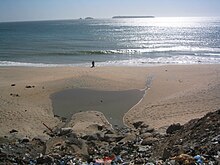Îles de la Madeleine (Senegal)
| Iles de la Madeleine | ||
|---|---|---|
| Waters | Atlantic Ocean | |
| Archipelago | Iles de la Madeleine | |
| Geographical location | 14 ° 39 ′ 17 ″ N , 17 ° 28 ′ 21 ″ W | |
|
|
||
| length | 650 m | |
| width | 615 m | |
| surface | 15 ha | |
| Residents | uninhabited | |
| Aerial view of Dakar from | ||
The Îles de la Madeleine are an uninhabited archipelago in Senegal . It is just under four kilometers off the Atlantic coast of the capital Dakar (corniche Ouest) near Cap Vert .
The 0.15 km² archipelago consists of the main island Sarpan (Snake Island), which is strongly rugged along the coast , and the Île Lougne , 250 meters southeast , a group of inaccessible rocky cliffs, some of which tower over 20 meters high. The islands and the surrounding fish-rich marine area with a total area of 50 hectares have enjoyed the status of the smallest national park in Senegal as Parc national des îles de la Madeleine since 1976 . and in 2005 it was included in the tentative list for recognition as a World Heritage Site by Unesco.
The main island forms a plateau of around 450 meters in all four directions, which reaches a height of up to 35 meters and is surrounded by steep cliffs. The north and east coast are fairly straight, with the exception of a 75-meter-long basin in the north with a rocky opening to the sea that is only 15 meters wide. Here is a piece of sandy beach at low tide. In the south of the plateau there is a cult place of the Lébou people , formerly the only inhabitants in the area around the Cap-Vert peninsula , as well as the square about six meters long foundation walls of a building that must be several centuries old. In the south, the plateau slopes gently towards a natural basin 30 meters long, 10 meters wide and 4 meters deep, the so-called Hubert Creek . Only here is it possible to moor with boats. Already Michel Adanson discovered this in 1749 on his expedition and that it is "safe to bathe here". The entrance to this landing bay is surmounted in the southwest by two mighty rock cliffs that stand side by side and push the coastline away from the island plateau by 250 meters. The west coast has other cliffs in front of it, which extend the plateau in the northwest even like a peninsula and form a bay on the west coast by 250 meters.
Because of the constant strong winds, the trees on the island only grow crawling near the ground “like lianas”. That is why you can find dwarf baobabs there . There are also lizards and geckos , tortoiseshell , black kite , cormorant , red-billed tropical bird , crested lark and weaver bird . The marine fauna features epinephelus , barracudas and tuna .
On the beach of Soumbedioune you can register with the national park administration all year round for a paid visit to the island of up to four hours.
See also
Individual evidence
- ↑ Île Lougne at Geonames
- ↑ Parc national des îles de la Madeleine near Planete Senegal
- ↑ Entry in the tentative list of Unesco
- ^ A Voyage to Senegal, the Isle of Goreé, and the River Gambia. By M. Adanson. London 1759 , pp. 115-120 in Google Book Search; Excursion to the Magdalen islands (English)
- ↑ Measure distances with google maps
- ↑ au-senegal: Îlot Sarpan. Le parc de la Madeleine, cormorans et pailles-en-queue


